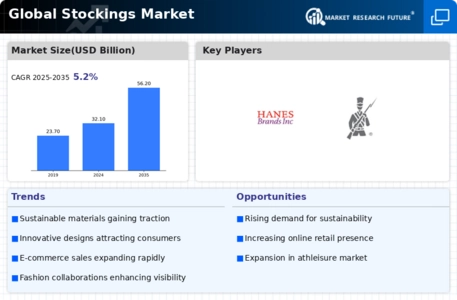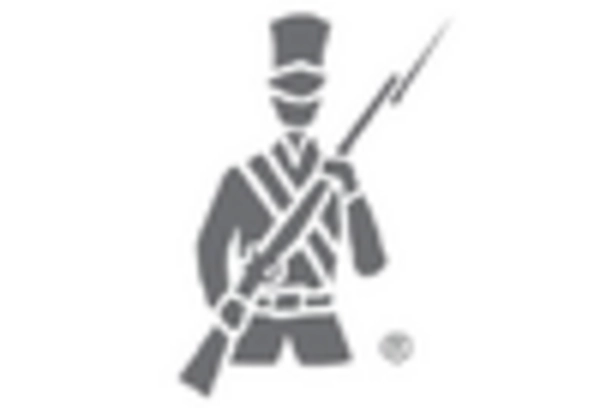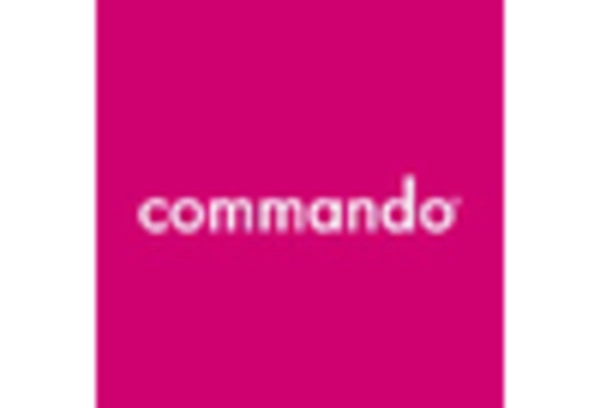Rising Fashion Consciousness
The increasing awareness of fashion trends among consumers appears to be a pivotal driver for The Global Stockings Industry. As individuals seek to express their personal style, the demand for various types of stockings, including patterned, colored, and textured options, has surged. This trend is particularly evident among younger demographics, who are more inclined to experiment with their wardrobe choices. Market data indicates that the fashion industry is projected to grow at a compound annual growth rate of 5.5% over the next five years, which could positively influence the stockings segment. Retailers are responding by expanding their offerings, thus enhancing the visibility and availability of stockings in the market. Consequently, this heightened fashion consciousness is likely to propel growth within The Global Stockings Industry.
Expansion of Online Retail Channels
The proliferation of e-commerce platforms is reshaping The Global Stockings Industry. As consumers increasingly turn to online shopping for convenience and variety, retailers are expanding their digital presence to capture this growing segment. Data indicates that online sales in the fashion sector are projected to account for over 30% of total sales by 2026, highlighting the importance of e-commerce in driving market growth. Retailers are investing in user-friendly websites and mobile applications to enhance the shopping experience, offering features such as virtual try-ons and personalized recommendations. This shift not only broadens the reach of stockings brands but also allows for targeted marketing strategies that cater to specific consumer preferences. As a result, The Global Stockings Industry is likely to see a significant increase in sales through online channels.
Influence of Celebrity Endorsements
Celebrity endorsements are playing a crucial role in shaping consumer perceptions within The Global Stockings Industry. High-profile figures often set trends and influence purchasing decisions, particularly among younger consumers who aspire to emulate their favorite stars. The strategic partnerships between brands and celebrities can enhance brand visibility and credibility, leading to increased sales. Market data suggests that products endorsed by celebrities can experience a sales boost of up to 20%, indicating the potential impact of such marketing strategies. As brands seek to differentiate themselves in a competitive landscape, leveraging celebrity endorsements may become a common tactic. Consequently, The Global Stockings Industry is likely to witness a surge in promotional activities centered around celebrity collaborations, further driving consumer interest and engagement.
Growing Demand for Eco-Friendly Products
The shift towards sustainability is becoming increasingly pronounced within The Global Stockings Industry. Consumers are now more inclined to purchase eco-friendly products, leading to a rise in demand for stockings made from sustainable materials such as organic cotton and recycled nylon. This trend is not only driven by environmental concerns but also by a growing awareness of the impact of fast fashion. Market data indicates that the sustainable fashion market is expected to reach USD 8.25 billion by 2027, suggesting a significant opportunity for the stockings segment to align with these values. Brands that prioritize sustainability in their product offerings are likely to attract environmentally conscious consumers, thereby enhancing their market share. Consequently, The Global Stockings Industry may experience a shift towards more sustainable practices, influencing production and marketing strategies.
Technological Advancements in Production
Technological innovations in manufacturing processes are transforming The Global Stockings Industry. Advances such as seamless knitting technology and the use of high-performance materials have enabled manufacturers to produce stockings that are not only aesthetically pleasing but also durable and comfortable. These innovations may lead to increased consumer satisfaction and loyalty, as products become more functional and stylish. Furthermore, the integration of smart textiles, which can provide additional benefits such as moisture-wicking and temperature regulation, is gaining traction. Market data suggests that the adoption of such technologies could enhance production efficiency by up to 30%, thereby reducing costs and increasing profit margins for manufacturers. As a result, The Global Stockings Industry is likely to benefit from these advancements, attracting a broader consumer base.


















Leave a Comment